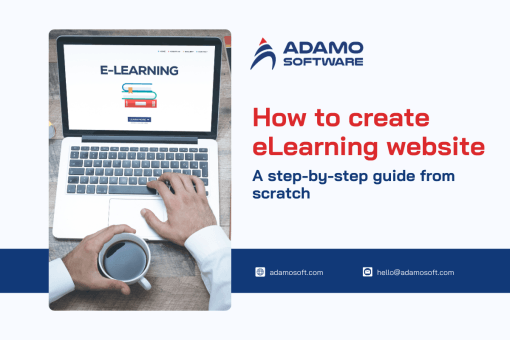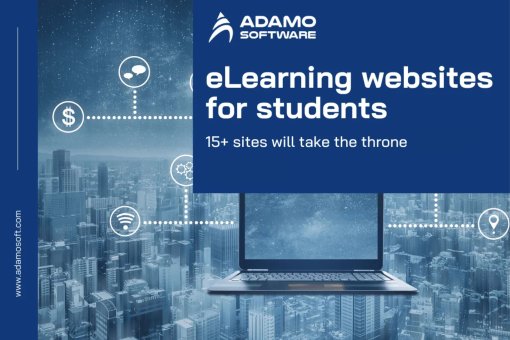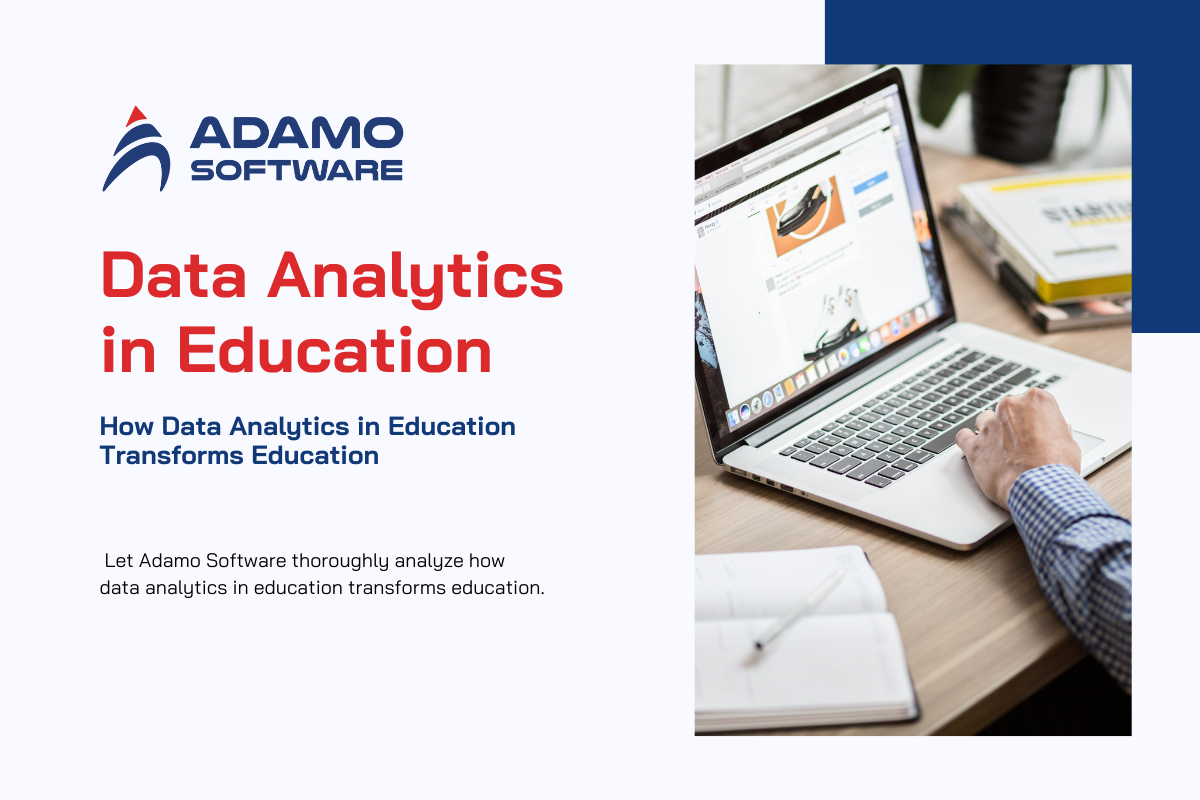
Collecting and analyzing learning data is extremely important for the education and training industry. The application of big data in education benefits both students and training units. This data source not only helps lesson designers understand the learners’ learning processes but it also provides valuable information to improve the quality of teaching and training and create a better learning environment. Let Adamo Software thoroughly analyze how data analytics in education transforms education.
Through this blog post, you will have an overall picture of big data in education, the importance of data analytics in education, and how you can apply data analytics in the education sector. Besides, the post also points out the difficulties of data analysis in education and offers measures to handle those challenges. Read our post for more detailed, well-researched, and up-to-date information.
I. What is Data Analytics in Education
Data analytics is the complex process of examining huge data sets to discover information like correlations, market trends, and customer preferences. With this process, each firm can build up its business process and growth path. Besides, it also enables businesses to make more accurate business decisions.
So, what is data analytics in education? It refers to the collecting, analyzing, and evaluating educational data process. These data can be generated by learners throughout their interactions with the learning environment. This process is aimed at optimizing learning or improving decision-making processes about learning, teaching, and educational management.
There are different types of data for data analytics in education. Here are some main kinds of information that educators can track and analyze.
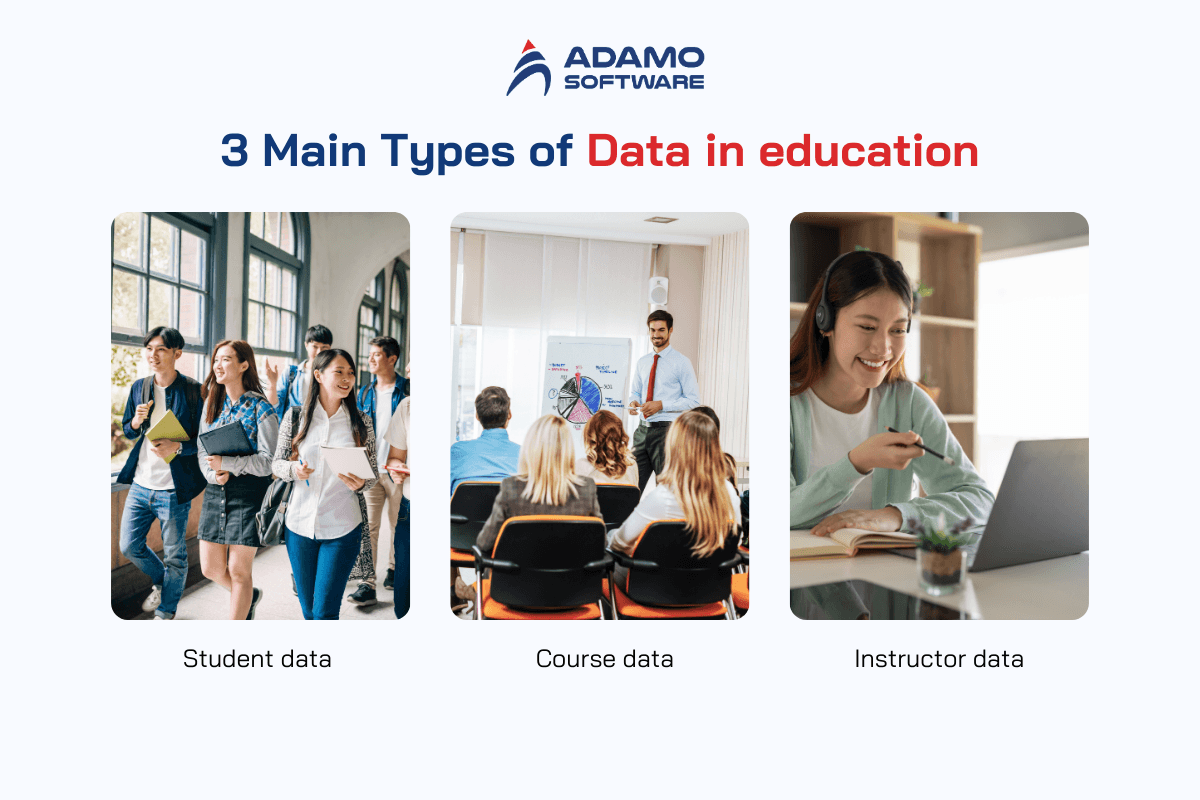
Student data
The student data includes information on student demographics (age, gender, educational base, religion, etc.), the number of lessons they attend, grades, and test scores. Besides, these data also show their learning behaviors and the platforms they learn.
Course data
The course data provides detailed information about subjects, class schedules (if available), number of course participants, scores, and completion rates by program or subject. Through this data, students’ learning trends can be unveiled.
Instructor data
Besides student data, instructor data is also a type of big data in education. The information in this database contains age, gender, salary information, and productivity levels.
Data analytics in education can be classified into three main groups. They exploit the same types of learner data but achieve different results. While the descriptive-analytic aims at analyzing available data, the predictive is performed to make predictions about learner progress, thereby identifying the learning quality of learners. Another type of data analytics in education is predictive analytics. This kind of educational data analytics predicts learners’ learning outcomes, thereby suggesting better and more appropriate resources and learning tools to use for teaching.
Overall, data analytics in education refers to the process of examining various kinds of data related to the educational field. It is the tool to convert these data into knowledge to improve the quality of education.
Also read: Gamification Examples in Education: Best Ways to Use Game-based Learning
II. Why Is Data Important in Education
Data analytics in education is becoming increasingly necessary, influencing various aspects from administrative decisions to classroom practices. Let’s find out:
1. Creating different curricula and tailoring learning methods
One of the reasons why data is important in education is that it can contribute to creating different curricula and tailoring learning methods for different individuals. Data analytics in education gives educators an overview of the learners’ needs, preferences, and learning styles. Thanks to that, they can create separate teaching programs targeting different groups of learners. Besides, not all learners have the same personalized lessons and learning methods for different individuals. For this reason, teachers must use collected and examined data to tailor lessons, instructional materials, and teaching methods to each individual. These materials can combine visual, auditory, and kinesthetic characteristics.
Through data analytics in education, educators can track their learners’ learning progress, which also facilitates personalized learning. By continuously assessing learner performance through quizzes, exercises, and engagement, data analytics in education helps teachers and trainers identify difficulties that learners are facing; thereby designing personal exercises from easy to difficult that suit their level. In addition to tracking the learners’ results, data analytics in education allows teachers to monitor student progress in real time, which also contributes to the development of personalized learning programs.
In addition, data analytics in education can be used by adaptive learning platforms to adjust the difficulty and content delivered to students based on their pace of learning and performance. Thanks to this, each student and learner can receive the support they need and be challenged appropriately.
2. Improving learning outcomes
Using data analytics in education is needed to improve the learning outcomes of the learners. Through data analytics, educators and institutions will have an overall insight into the way learners learn so that they can enhance their teaching methods and support learners more effectively. Let’s see how data analytics in education can improve educational impact.
Enhanced Assessment and Feedback
Descriptive analytics allows educators to evaluate student performance continuously through various formative assessments. Through ongoing evaluation, they can identify students’ learning gaps and areas for improvement. In addition, the instant feedback on students’ performance given by automated systems enables students to understand their mistakes and learn from those mistakes.
Creating strategies for data-informed teaching
By examining the data on students’ performance, educators can determine effective teaching strategies and refine their teaching methods accordingly. Data insights help educators know which parts of the curriculum are effective for students and which parts are not really necessary so that they can adjust the curriculum.
Overall, data analytics in education offers powerful tools for improving outcomes by identifying at-risk students, enhancing assessment and feedback, and creating data-driven instructional strategies. Besides, data analytics also helps students track their learning progress, set goals, and ask for help, which contributes to improving their learning outcomes.
3. Optimizing resources in educational institutions
Data analytics in education helps to optimize resources in educational institutions through the data insights collected. These insights help allocate funds, personnel, and materials more efficiently and effectively. Here are some ways data analytics can optimize resources in schools, universities, and training units.
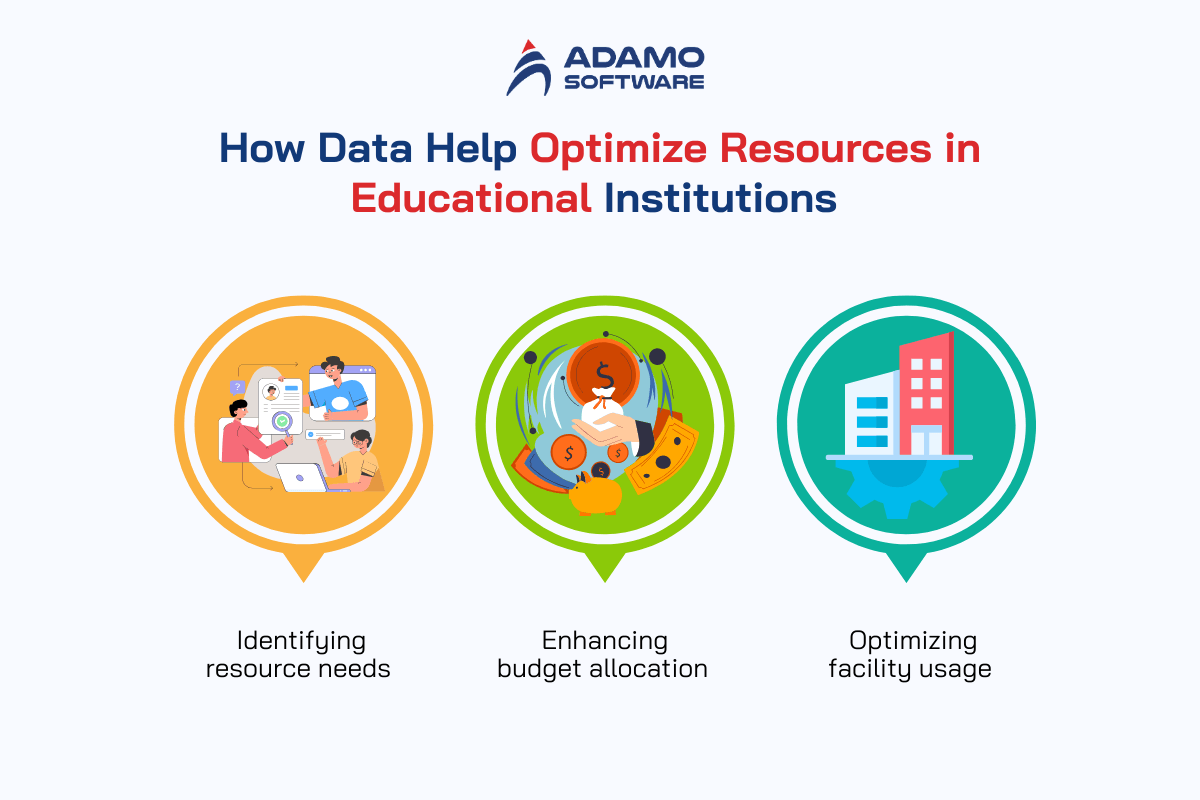
Identifying resource needs
The data on the number of enrollments for a course shows which courses are more popular among learners. By analyzing this data, institutions can decide which course requires more investment, more resources, and staff and ensure that they are adequately prepared to meet student demand. Through the utilization rates of various resources like classroom spaces, and library materials, schools, universities, and training units can reallocate and repurpose underutilized resources.
Enhancing budget allocation
Data analytics in education enables institutions to allocate budgets more effectively. Analytics can ensure that funding is distributed based on actual needs and performance metrics, thereby encouraging efficient use of financial resources.
Optimizing facility usage
Besides online resources such as study materials and online courses, data analysis in learning also helps effectively allocate physical resources such as classrooms, laboratories, and other facilities. Data on facility usage and maintenance can help plan preventative maintenance, reducing downtime and extending the lifespan of physical assets.
In general, data analytics in education is important due to its benefits to both institutions and learners. Besides those benefits, data analytics also enhances student engagement with interactive and meaningful learning experiences. Regarding the usage of data analytics in education, let’s keep reading for more detailed information.
III. How Data Analytics Is Used in Education
Data analytics is used in education in many ways so that teaching, learning, and administrative processes can be boosted. Let’s find some key applications of data analytics in the educational field.
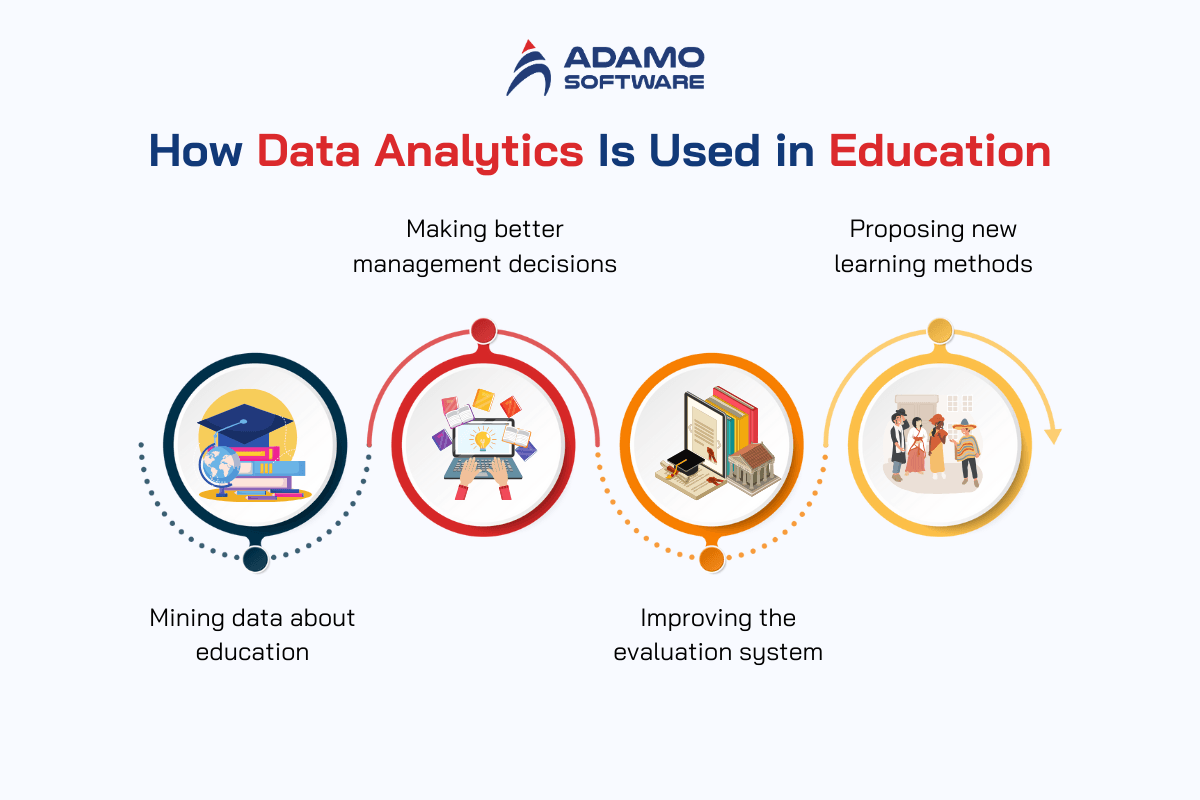
1. Mining data about education
Mining educational data is a specific application of data analytics in education that aims to improve learning outcomes and enhance educational processes. The predictive data in data analytics helps to detect students who are likely to drop out of school or have poor results by monitoring their attendance, grades, and engagement. Thanks to this, schools and training units can provide timely interventions, such as tutoring, counseling, or additional resources.
Besides helping detect at-risk students early, data analytics can exploit students’ and learners’ behaviors in a learning environment. This data mining is based on the time learners spend on tasks, the participation and engagement of the learners in classes, and click patterns. Deeply understanding learners’ interaction with the content, the subject, and the classes enables educators to design more engaging and motivating learning experiences. Besides, educational data mining also evaluates teachers’ performances and provides insights into teacher effectiveness.
Data analytics in education can apply classification, clustering, and regression techniques to mine the data. The classification technique can group learners strategically to optimize learning experiences, based on their performance, engagement, or other relevant factors. Whereas, the clustering technique matches learners with peers who share similar learning styles. Completely different from the other two techniques, the Regression technique, instead of grouping learners together, predicts learning outcomes based on many different factors such as interaction data and past performance.
Overall, data analytics in education can be used to mine educational data that offers deep insights into student behavior, performance, and engagement. These mined data will then become one of the effective tools to improve teaching strategies and learning outcomes.
2. Making better management decisions
Educators can use data analytics to make smarter, data-driven choices, leading to more effective administrative practices. Through predictive analytics, educational leaders can anticipate enrollment trends based on historical data, demographic changes, and market conditions; thereby having better planning for future student intakes. By revealing which programs are popular and which ones are less attractive, data analytics empowers administrators to make informed decisions. They can decide to expand, modify, or stop unpopular study programs.
Besides making decisions about the training programs, data analytics also helps educators make a determination on the tuition fee, financial management, and cost control. Thanks to the data on these sectors, it will be easier for educators to forecast the schools’ revenues.
In general, educational leaders can leverage data analytics to make informed, strategic decisions. These decisions can create a more responsive, effective, and sustainable educational environment.
3. Improving the evaluation system
Schools can monitor students’ abilities through many different subjects individually and collectively, thereby developing appropriate solutions to support students. Statistical analysis of students’ scores across different subjects helps better orient and build a suitable learning path.
Teachers can orient their future career paths based on achievements in their respective subjects and interests. They can also point out the factors that affect academic achievement and provide effective solutions through this analysis.
4. Proposing new learning methods
Proposing new learning methods is also an application of data analytics in education. Although there are many available methods for learners to learn; for example, reading, memorizing, or watching videos, etc., not all students are familiar with these methods. They may have trouble getting used to specific methods, which are sometimes not suitable and hinder their development. That also affects students’ learning outcomes. This is one of the reasons why data analytics is needed. Through data analytics in education, schools can build different learning methods, making learning more interesting. Thanks to that, students can understand more about their strengths and weaknesses and access to useful learning materials.
Overall, data analytics is a powerful tool in education, offering insights that drive improvements in teaching, learning, and administration. The ongoing integration of data analytics into education promises to transform how we teach and learn, making education more effective, efficient, and equitable.
IV. Challenges of Data Analytics in Education – How to Tackle
Although the benefits and applications of data analytics in education are undeniable, it also has many challenges related to data security, data quality, technical expertise, etc.

1. Difficulty with huge amounts of data
When implementing data analytics in education, educational facilities may encounter challenges related to the vast amount of data. This not only puts pressure on the human and physical resource infrastructure to leverage data but also challenges the ability to process and analyze data effectively. If this large amount of information is not processed quickly and efficiently, it can result in the loss of important information or reduced performance of the analysis process.
The ability to store, manage, and preserve data is also a big challenge, especially when data is collected from many sources and has many formats like graphs, charts, drawings, etc. Ensuring consistency and visualizing data for analysis is a complex process. Here are some strategies to tackle this problem.
- Using cloud storage solutions to store and implementing a data warehouse to manage large amounts of data
- Using distributed computing frameworks to reduce the data processing time
- Utilizing automated data cleaning tools to clean and preprocess data
- Employing machine learning algorithms and artificial intelligence to analyze the data
In short, having too much data is one of the challenges that educational institutions face. To solve this challenge, it is necessary to combine many technological solutions.
2. Lack of data privacy and security
Lack of data privacy and security is also among the challenges of data analytics in education. For many educational institutions, the collection and processing of sensitive learning and training data raises major information security and privacy concerns. Without strong security measures, they may face significant risks of losing critical information, student and staff data, and even system security breaches. So, it’s time to implement strong data encryption practices and security protocols to protect information. Here are some of the ways to prevent and solve data leakage problems.
- Implementing robust secure measures: encrypting databases, and files, restricting access to data, etc.
- Ensuring compliance with relevant data protection regulations
- Conducting regular data audits and assessments
- Securing data storage and backup
- Using secure technologies
- Monitoring systems and networks regularly to detect and respond to suspicious activities and potential security threats
By implementing the above strategies, schools, universities, and training units can protect data and build trust with students, staff, and stakeholders.
3. Technical expertise
Another challenge when implementing data analytics in education is lacking technical skills among educators and administrators. Without complete training, they may face problems in analyzing and interpreting data effectively. So, how to deal with this situation? Here are some solutions.
Organizing professional development and training programs
Educational institutions may want to hold regular workshops and internal training sessions about data literacy, data analytics tools, and interpreting data insights. Besides, in-house training programs tailored to the specific needs of the institution are also needed.
Encouraging collaborative learning
In an educational institution, people with good knowledge of data analytics in education can share their knowledge and experience with others. This is a good way to deal with lacking technical expertise problems.
Overall, addressing challenges with data analytics requires a comprehensive and strategic approach. Once those challenges have been resolved, teaching, learning, and data management processes will be enhanced effectively.
V. Final thoughts
Big data analytics offers unprecedented insights into students’ learning process, curriculum, teacher effectiveness, and students’ behavior and performance. To fully realize the benefits of data analytics in education, educational institutions must approach robust data infrastructure, advanced analytics tools, and strong data governance.
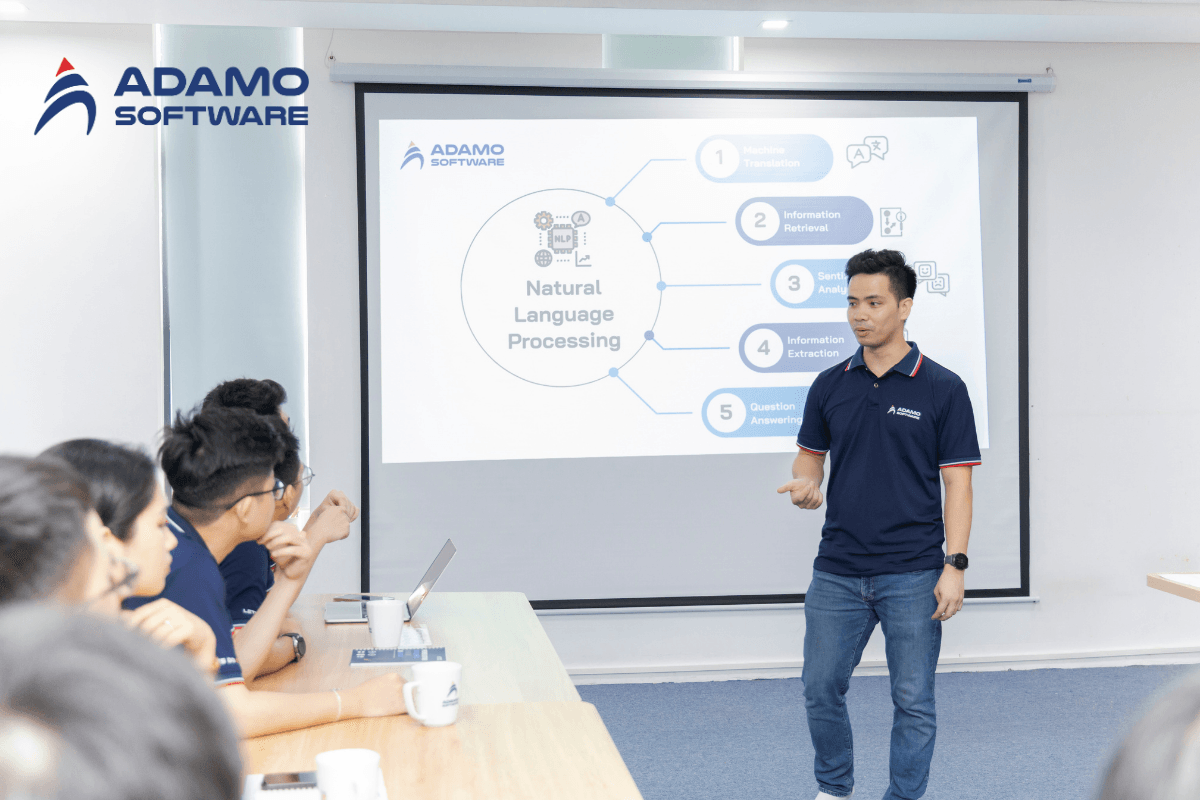
Partnering with specialized educational software developers like Adamo Software creates the opportunity to integrate big data analytics into existing educational management systems. With a team of experienced and professional experts, we are confident in providing impressive solutions to deal with a large amount of data on the educational sector.
So, if you are looking for a unit that can help you with software solutions for data analytics in education, Adamo Software may be your choice. Contact us for a more detailed consultation.







